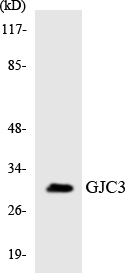Connexin 31.3 Polyclonal Antibody
- 货号:YT1042
- 应用:WB;ELISA
- 种属:Human;Mouse
- 蛋白名称:
- Gap junction gamma-3 protein
- 免疫原:
- The antiserum was produced against synthesized peptide derived from human GJC3. AA range:151-200
- 特异性:
- Connexin 31.3 Polyclonal Antibody detects endogenous levels of Connexin 31.3 protein.
- 组成:
- Liquid in PBS containing 50% glycerol, 0.5% BSA and 0.02% sodium azide.
- 来源:
- Polyclonal, Rabbit,IgG
- 稀释:
- WB 1:500 - 1:2000. ELISA: 1:40000. Not yet tested in other applications.
- 纯化工艺:
- The antibody was affinity-purified from rabbit antiserum by affinity-chromatography using epitope-specific immunogen.
- 储存:
- -15°C to -25°C/1 year(Do not lower than -25°C)
- 其他名称:
- GJC3;GJE1;Gap junction gamma-3 protein;Connexin-30.2;Cx30.2;Connexin-31.3;Cx31.3;Gap junction epsilon-1 protein
- 背景:
- This gene encodes a gap junction protein. The encoded protein, also known as a connexin, plays a role in formation of gap junctions, which provide direct connections between neighboring cells. Mutations in this gene have been reported to be associated with nonsyndromic hearing loss.[provided by RefSeq, Feb 2010],
- 功能:
- function:One gap junction consists of a cluster of closely packed pairs of transmembrane channels, the connexons, through which materials of low MW diffuse from one cell to a neighboring cell.,similarity:Belongs to the connexin family. Gamma-type subfamily.,subunit:A connexon is composed of a hexamer of connexins.,tissue specificity:CNS specific. Expression is restricted to brain, spinal cord, and sciatic nerve. According to PubMed:12881038 expression is abundant in skeletal muscle, liver, and heart, and to a minor degree in pancreas and kidney.,
- 细胞定位:
- Cell membrane ; Multi-pass membrane protein . Cell junction, gap junction .
- 组织表达:
- CNS specific. Expression is restricted to brain, spinal cord, and sciatic nerve. According to PubMed:12881038, expression is abundant in skeletal muscle, liver, and heart, and to a minor degree in pancreas and kidney.

- Western blot analysis of the lysates from K562 cells using GJC3 antibody.




